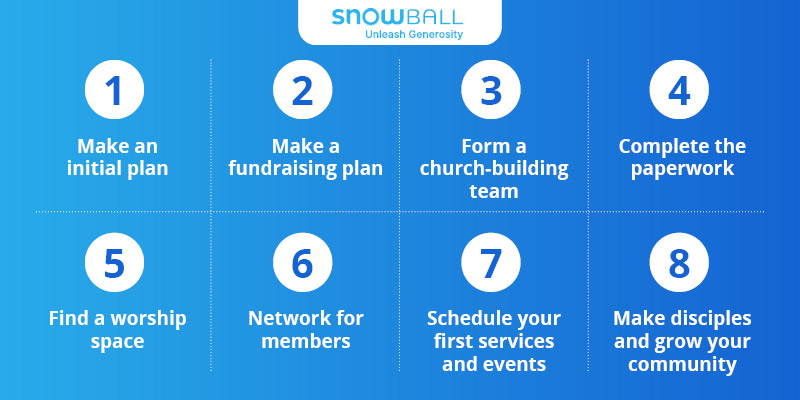If you feel a calling to plant a church, then you truly are in for an incredibly rewarding spiritual adventure. Starting a church can be a great way to spread the good news in your community to many unchurched people, and to boost community engagement among local members.
Yet too many times, people get caught up in the excitement of their church planting experience, become overwhelmed with all the moving parts, or fail to conduct the necessary research to ensure success. No matter how honorable their intentions, the plans for the church ultimately fall through.
Don’t let that happen to you!
This step-by-step guide is designed to help you work through the planning, fundraising, paperwork, and other essential processes involved in starting your church. With a guide like this one, you can keep your mind focused on the most important aspect of your church, and the reason you’re doing this all in the first place: Jesus.
What is Church Planting?
Church planting is the process of establishing a new church to spread the Gospel to new audiences and creating a positive impact on one’s community.
The term church planting uses the imagery of botanical growth to further demonstrate the metaphors of sowing and reaping that are so present in the New Testament. For some great examples of successful church planting, be sure to read through the book of Acts as it chronicles the growth of the early church by Paul and other key disciples!
In this handy guide, we’ll walk through the main processes involved in starting a church step-by-step, along with a few bonus church planting for finding success.
How to Start a Church: Essential Steps
There’s a lot that goes into planting a new church. Between coming up with a game plan and finding the necessary funding to carry through, you might not know where to start. For your convenience, we have created this complete 8-step guide to simplify the church-planting process:
- Starting a Church Step 1: Make an initial plan.
- Starting a Church Step 2: Make a fundraising plan.
- Starting a Church Step 3: Form a church-building team.
- Starting a Church Step 4: Complete the paperwork.
- Starting a Church Step 5: Find a worship space.
- Starting a Church Step 6: Network for members.
- Starting a Church Step 7: Schedule your first services and events.
- Starting a Church Step 8: Make disciples and grow your community.
[boc_button href=”https://share.hsforms.com/1bg_XfAL3Rl-4OWa9GFM8pw3gcjg” btn_content=”Apply to Contribute to the Snowball Blog” target=”_self” size=”btn_medium” color=”btn_theme_color” btn_style=”” border_radius=”btn_rounded” icon=”” icon_pos=”” icon_effect=””]
Just remember, even as we walk through the logistical side of starting a new church, it’s important to never lose focus of the core mission that is driving you. Are you ready to jump in to find the most effective ways to start a successful church? Let’s get started!
Starting a Church Step 1: Make an initial plan.
The first step to start a new church is to make sure you have an initial plan in place. This guide is the perfect place to begin the creation process. Be sure to include the steps spelled out in this guide as well as any others you pick up along the way.
The first part of this “how to start a church” plan should help define your church’s mission. Spelling this out from the get-go will help you keep your overall purpose in mind throughout the entire process.
Your mission should define who you are, what you believe, and what you wish to bring to the community.
Other decisions that should be laid out in the very beginning of your plan include your church’s:
- Name: Choosing the perfect name for your church is key because it’ll be the first thing potential members will hear about you! Common naming strategies include using the denomination and/or location, but you may opt for a more unique or intriguing name instead.
- Denomination: Between Catholic, Baptist, Presbyterian, Methodist, Episcopal, Lutheran, and many more, you have quite a few denominations to choose from. Or, you may choose to go non-denominational!
- Goals: What are your goals in starting this new church? Whether your main objective is to spread the Gospel to those who have not previously heard or to strengthen the bonds between various groups in your community, having specific goals in mind is key.
- Brand: Decide whether you want to be a traditional church or a more contemporary one, which will dictate key elements such as atmosphere and music choices. It’s also essential to set your church apart from others in the area, especially if there are already a ton of local churches in the community.
While your mission acts as a guide for your church, hammering out the other details will set your church up for success. Whether you are planting a church from the ground up or starting one in an established community, you’ll need to figure out some essential details before you can jump into the other fun processes.
Church Planting Bonus Tip: Pray frequently!
Being called to plant a church is truly a gift, but one that can seem overwhelming at times. As you work through huge decisions concerning your new church and its mission, relying on prayer to guide you through the toughest of times is an important founding principle to never lose sight of.
Make sure you’re constantly bringing your prayers to the Lord, and listen as he guides you through key obstacles such as gathering support for your new church, financial concerns, and ensuring wisdom in teaching.
Starting a Church Step 2: Make a fundraising plan.
One of the major activities your church will need to take part in at the very beginning of the creation process is fundraising— whether that be online, in person, or through fundraising letters.
You’ll need funds for startup costs, facility management, software implementation, and all sorts of other expenses. Therefore, having a comprehensive fundraising plan in place is vital to starting a new church.
Apply For An Employer Identification Number
An EIN, or Employer Identification Number, is used for tax purposes by the IRS for new organizations. You may be vaguely aware of what an EIN is because it is required for the W-4 paperwork you complete when you begin working at a new job.
But in this context, think of this number as a license of identification for your church. It will be required to open a bank account and conduct other fundraising efforts, as well as to withhold income and Social Security taxes from employee paychecks.
Be sure to read up on the rules and regulations regarding your EIN— and the role the IRS will play in the payroll of your church’s employees. However, it’s important to note that you’ll need an EIN even if your church does not have an official, paid staff.
The form to fill out for this identification number is called an SS-4. If you are especially worried about this process, we recommend hiring a lawyer or consultant to help guide you through the legal details of the process.
Open A Bank Account
Open a bank account in the name of your church so that you have a place to start handling all the necessary finances. Be sure to research the banks in your area and decide which one will best align with your needs as a church.
Some of the aspects to look for in a new bank before opening your account include:
- Location. Consider how important the location of your bank is to you, then narrow your list of banks by the area in which you are willing to drive to access the nearest branch or ATM.
- Monthly fees. Your account should never be impacted too heavily by the existence of fees at your bank. Be very careful with your expected budget when considering potential monthly fees, and shop around for the best possible deals.
- Minimum opening deposits. If your bank requires a minimum amount to open a new account, be sure you have that available to get the bank account opened right away.
- Minimum balances. Many accounts require a certain amount to be present in the bank account at all times. Be sure that if your account requires a minimum, you are confident that you’ll never drop below that amount— now or in the future.
- Loan availability. You may need to take out a loan to jump-start the creation process for your church. It is much easier to manage these loans if they are present at your home bank.
The top priority for your church’s bank account is to ensure that it will support your mission. The last thing you want is to partner with a business that doesn’t support your mission. Try asking other church officials in the area who they bank with (and their experiences with that bank) to get a better understanding of your options.
Set Up Donation Platforms
In order to collect tithes, offerings, and donations from supporters, you’ll need to provide access to a reliable giving platform. You’re no longer limited to just passing the offering plate around on Sunday mornings!
Some modern donation methods to consider for boosting your church revenue include:
- An online tithing tool. Online giving tools are essential in this digital age. We suggest getting this tool set up and customized for your new church as soon as possible, to help you collect gifts right away. Plus, you can set up this tool to deposit gifts directly into your new bank account.
- Text-to-tithe services. These tools are great for younger audiences who may not carry cash to church on Sunday mornings. We can almost guarantee they’ll have their cell phones. Setting up a text-to-give number will enable them to give from the pew and provide them with an excuse to check their cell phone.
- Crowdfunding. Crowdfunding is a great resource for individual projects you will run into while starting a church. For instance, you may launch a campaign through a top crowdfunding website to help fund your purchase of new pews for your sanctuary.
- Fundraising Events. Fundraising events are a great way to get supporters more involved with your church’s activities while also raising money for your mission-focused goals. These opportunities may become more available in the later stages of your church planting.
- Live-streaming platform: A live-streaming tool is a must-have if your church will incorporate virtual services and other events. Not only is this critical for encouraging online engagement, but with the right software, you can even integrate your online giving tools with your live-streaming platform. This process will allow for a seamless participant experience.
These giving platforms need to appeal to a wide variety of supporters— especially to your entire targeted audience. For example, if your church primarily targets a middle-aged to young adult audience, you may choose to emphasize online giving and text-to-give efforts as a way to appeal to a tech-savvy audience.
There are countless methods of fundraising for your church. We’ve compiled many of them into a list for you to ponder. Check out our list of the top 85+ church fundraising ideas for your new church, from online giving engagements to family-friendly events and more.
Apply For A Grant
To help take care of the startup costs to start your church, it may be beneficial for you to look into applying for a grant. You can seek startup grants through grant-giving foundations, private foundations, and other organizations that may provide support for developing churches.
Grants are seed-money from investors in your church. They are especially important if you plan on partnering your church with a new or existing local nonprofit organization. While not every corporation is willing to provide grant money to a religious organization, they may be more willing to help strengthen the partnered nonprofit.
Church Planting Bonus Tip: Communicate your intentions.
Communication is the key to building trust with your church’s members and prospective attendees. Although it might make you feel vulnerable to be entirely transparent with your supporters, it is a necessary step to establish trust for your new church.
This trust is so important for your church planting process. It gets harder when things don’t go exactly as you planned— but you should still communicate the truth in these trying times! When people trust your leadership, they will be more likely to give to the project, pray for your success, and become a member down the line.
Starting a Church Step 3: Form a church-building team.
Starting a church requires a team of leaders to help the church grow and prosper. This means you should decide what kind of leader you’ll be, as well as choose others to help run the church.
Depending on the style and denomination of your church, this team of leaders may look different from other churches in the area.
Ask yourself some questions to start the process of looking for a leadership team:
- What kind of preacher will you be?
- What positions are often required for your church’s denomination?
- What values do you want leaders to represent in your church?
- How will you find candidates? The internet? Personal relationships?
You may choose to appoint positions like bishops, elders, sessions, councils, or ushers. No matter the name of the positions, this team should be established early to ensure proper management of your church. Effective management leads to that initial boost of growth you need to get your church up and running.
Church Planting Bonus Tip: Ask for help when you need it.
When planting a church, we tend to want to give and give and give to the community. After all, giving back is part of the reason we are establishing a church in the first place!
That’s what makes asking for financial help one of the most difficult tasks for leaders planting a church. However, it is also one of the most crucial tasks in the church planting process. Fundraisers not only help raise money but can also help to spread the word about your church and allow your community to get acquainted with your new church leadership team!
Starting a Church Step 4: Complete the paperwork.
There’s a lot of legal paperwork that goes into starting a church, but most people fail to consider this aspect of the church commencement process when they start dreaming up the idea.
It’s usually a good idea to hire an attorney to help you through all the official paperwork that your church needs to get its start, to ensure that you get everything accurately filled out on time!
In addition to the EIN (which we covered earlier), you’ll need to complete the applications for a Certificate of Formation and a 501(c)(3) status.
Certificate Of Formation
One of the first major steps that you need to complete to establish your church is to obtain a Certificate of Formation, which makes your church official in the eyes of the government.
Plus, it ensures that the chosen name for your church is unique. Most states require you to file this certificate of formation with the Secretary of State, so be sure to check the specific laws for your state regarding the rules for this certificate.
501(C)(3)
You’ll need your official EIN to apply for a 501(c)(3), which is essentially a tax-exempt status for your church.
501(c)(3)s tend to be considered in terms of nonprofits, but not exclusively! The application process for your church is the same as it would be for a nonprofit organization. And while your church is not required to apply for this status, it can get very expensive very quickly if you decide against it.
Drafting Your Church’s Bylaws.
Think of your bylaws as the Constitution for your church— this is where you lay out all of the internal rules and governance that your church will abide by. If you haven’t hired an attorney yet, this is another time that many churches decide they need some legal assistance.
When drafting your church bylaws, you’ll need to include information such as:
- Member qualifications and expulsion rules.
- Worship times and meeting places in addition to those of other regular meetings.
- Qualifications for and responsibilities of church board members and leadership positions.
- The procedure for amending standing bylaws.
This official document will hold accountable your church leaders, board members, and other key individuals, so while the paperwork may not be the most exciting part of starting a church, it is a necessary task for the governance.
Plus, spelling out the rules in bylaws forces you to set standards upfront instead of waiting until something goes wrong. If something does go wrong (although we all hope it doesn’t!) this document protects your church from un-standardized processes.
Church Planting Bonus Tip: Carefully craft your mission statement.
When writing your new church’s mission statement, follow the steps featured in our guide for nonprofit mission statements. Your mission statement should encompass your vision for your new church, act as a guiding force for the church itself, and will help your church plant to blossom down the line.
Use your mission statement as a positive force to drive your church forward. This is the underlying statement for all of your actions, meaning it will be ever-present in your mind. Take the time to make your statement a good one!
Starting a Church Step 5: Find a worship space.
Finding a worship space gets us back to the part of starting a church that is much more fun! Worship spaces set the mood for the type of church you are going to lead.
You probably have an idea about whether your church will be more traditional or contemporary. To decide what type of church you want to build, consider the following attributes of each:
- For traditional churches, you may want to invest in stained glass for the windows. This can add a beautiful touch to the space and set the mood for worship. Most traditional churches include wooden pews, a standard pulpit, and a center aisle for processionals. Traditional churches often take advantage of a lot of natural light.
- More contemporary churches may include elements like a projector and a screen on a front wall for song lyrics or sermon points. You may want to build a stage up front for a worship band and the pastor to preach. A darker setting with stage lights tends to set the mood in this contemporary atmosphere.
You’ll also need to start thinking about how many people will attend. You want to be sure your church’s space will hold all of your members but is not so big that they’ll feel overwhelmed. Be sure your church’s space is designed with your congregation in mind. What will help them keep their focus on worshipping the Lord whilst attending your church?
Keep in mind, if you change locations after your EIN has been applied for, be sure to update this information with the IRS!
Whether you’re building from scratch or renovating an existing building, we recommend launching a capital campaign to fund the project. While your standard fundraising efforts are essential to financing your annual fund and other smaller projects, capital campaigns are designed to provide organizations with the funding for major projects.
Church Planting Bonus Tip: Focus on your supporters.
In a post by Christianity Today, Aaron Damiani says, “Jesus builds his church, so stop watching the door and start feeding your people.” While recruiting new members is important to the growth of a new church, nurturing existing relationships is just as important as building new ones in the church planting process.
Building your church from the inside will only strengthen your foundation. Not only that, but this is also probably where you will find the source of the majority of financial contributions to your church.
Therefore, your organization will improve both structurally and financially by focusing on your current supporters. Be sure to ask for help, lift up prayer concerns, and provide ample opportunities for involvement.
Starting a Church Step 6: Network for members.
Your church is not defined by the space in which you worship or the name you put on your EIN application. Instead, it’s the members who worship and the relationships that grow there that really count.
Member networking to get more congregants through your doors is, therefore, an essential part of starting and growing your church. Networking includes communications through your established network as well as cold outreach to reach new individuals.
Your networking strategies might include tactics like these:
- Extending invitations to church events. Encourage your members to reach out to their family and friends and bring them to various stewardship and fundraising events. You can even send physical invitations via direct mail to individuals in your community to encourage them to join for a service!
- Launching a peer-to-peer fundraiser. This fundraising technique is used to raise money and get the word out about your church. Your supporters will create fundraising pages and raise money on your behalf through their online networks.
- Ensuring an up-to-date online presence. Your church’s website and social media presence can make a great impact on your online visitors. Allow interested people to enter their emails on your website so that you can send targeted emails later on. Be sure you regularly update your social media pages so people can keep up with your growth.
Established network outreach is great for the continual growth of your church. However, you need to first go through the process of establishing that network with initial cold outreach strategies to get the ball rolling.
While networking is key, it’s important that you don’t get too caught up in it. Remember to remain available and focused on those you’ve already recruited to join your church. These individuals deserve a good portion of your attention to retain their interest and keep them bringing in new members along the way.
Church Planting Bonus Tip: Work with a direct mail platform to get the word out about your church.
When you’re looking to get new churchgoers through your doors, it’s important that you reach out in a variety of ways to grab their attention and begin building a relationship with them. Therefore, you don’t want to skimp on the communication and outreach strategies you choose. One of our favorite tactics is direct mail.
If you invest in beautifully crafted, high-quality mailings, for example, it shows that you put the time, effort, and resources into your message in a meaningful way. A scrawled letter on a piece of notebook paper or a poorly worded email, on the other hand, sends an entirely different message to your audience. So how can you make sure your outreach makes an impact on the recipient? We suggest working with a direct mail marketing platform to get started.
Starting a Church Step 7: Schedule your first services and events.
The average church service usually falls between one and two hours, but this all depends on your sermon style and the individual church itself. Ask some thoughtful questions about your church and your style as a preacher to decide how long to schedule worship services.
Regardless of whether you’re hosting services online, in-person or a combination of both, the right church management software can help you produce engaging church gatherings for your congregation. Here’s how:
- Real-time displays for Bible verses and song lyrics allows attendees to follow along
- High-quality presentation software provides your church with a professional look
- Interactive media and survey options encourage viewers to become active participants
It’s also important to recognize that seemingly minute details can make a big difference in your services’ overall quality. By considering these logistics, you can set your church up for accessible, transformative services.
Once you’ve taken into account how and when you’ll host your services, you’re only halfway to being done. Your congregation will also love getting together for more events like:
- Mission trips. Mission trips could be in another country or just down the street— help is needed everywhere. These trips make a great bonding experience for your new church members to form strong relationships while helping out the community. Consider designing custom t-shirts for your missionaries to remember this special event and to raise more funds for the cause.
- Fundraising events. Church fundraising events are a great way to bring the church congregation together for a cause everyone cares about: the well-being of your house of worship. Be sure you make it clear what your fundraising campaign is raising money for and how members’ contributions will help.
- Stewardship events. These events are designed to bring people together for conversation and relationship-building. Try hosting a potluck dinner on Sunday evening or a weekly Bible study. Not only will members build relationships with one another, but they’ll build a stronger rapport with the Lord as well.
Get started with your event planning early to help establish your church as an active entity. Members are more likely to become deeply involved in your new church if you have fun events going on from the very beginning. This is a key way to nourish relationships with members and get new attendees through the door.
Church Planting Bonus Tip: Don’t get discouraged by large projects.
There are a lot of moving pieces involved with church planting, and it can be easy to get discouraged, especially by large projects. One of the biggest projects you will undergo is building a worship space. This can mean building a sanctuary from the ground up or renovating an existing building. Either way, it’s a challenge (and an expensive one!)
You’ll likely begin to feel a bit discouraged at one point or another in the process of planting your church. Just don’t let it get you down! If you keep on pushing through with faith, prayer, and trust— and a willingness to adjust your plans as necessary— you’ll find a way through.
Starting a Church Step 8: Make disciples and grow your community.
You’ve planted the seed with the establishment of your church; now it’s time to grow your church family even more and make disciples in the name of God.
Keep your best growth practices in mind while you expand your services:
- Maintain effective communication. Keep members and supporters up-to-date with all of your church happenings with effective communication strategies! Find the right combination of digital, traditional, and face-to-face methods to stay in touch with your congregation.
- Continue to reach out to the community. Inform community members of your new church and its main purpose to gather new attendees. Be sure to reach out to both unchurched individuals and those involved in other local groups.
- Welcome new members. When new individuals do walk through your doors for the first time, be sure that you and your team are friendly and welcoming to all. Getting involved in a new church can be nerve-wracking, so you want to make it as easy as possible for new members of all walks of life!
- Keep a strong leadership presence. Make sure you have the right individuals in positions of power within the church to provide a solid foundation and strengthened leadership team. Leaders must be able to make wise decisions through this time of growth and continuously look to the Lord for guidance.
- Nurture a strong congregation. Create an environment that encourages strong community relationships by hosting local events, promoting a welcoming environment, and urging everyone to get involved!
With these tips in mind, your church will continue to expand and reach more people in the future. You will have created a lasting impact for each member of the church and the community as a whole.
Church Planting Bonus Tip: Remain flexible as you grow.
One of the key steps involved in planting a church is planning. You need to make plans for accepting contributions, building a sanctuary, boosting membership engagement, expanding your network, and more. However, along with the creation of each of these plans, you need to be prepared for them to fail.
Everyone hopes for as few hiccups as possible when planting a church, but chances are you’ll run into at least one problem. This is when it is important to remain flexible— when things go wrong, you need to have the ability to readjust and keep on moving forward.
Only God knows what the future holds. When you’re planting His church, be sure to trust that He will guide you where you’re supposed to go!
Wrapping Up
Church planting is an exciting and moving experience. As you follow these 8 essential steps, you’ll be ready to proclaim the word of God far and wide through your new church. For more helpful information on creating the best church you can, check out these free resources below:
- Church Management: 16 Simple (And Effective) Tips. Snowball’s tips for managing your church will help take your church to the next level. Read through these 45+ tips to see how!
- Top 11 Awesome Church Giving and Donation Tools. Double the Donation’s guide to church giving tools will help you find the best software to collect donations to kick-start your church.
- 85+ Awesome Church Fundraising Ideas for Your Congregation. Looking for more fundraising ideas? These 85+ ideas have anything and everything you’re looking for to raise money for your church.
- 9 Essential Church Communication Letters. Ensuring effective communication practices with your new congregation is vital to establishing and growing your church. Find out what each of these letters can do for you!
- Church Newsletters: A Complete Guide to Modern Communication. Keep members and supporters up-to-date with the happenings around your new church, such as fundraising efforts, building updates, and staffing with a well-crafted newsletter.
- Church Fundraising Letters: An Essential Guide to 2020 and Beyond. How can you use fundraising letters as a modern fundraising practice? Find out how to craft effective, personalized donation request letters in this decade.





















